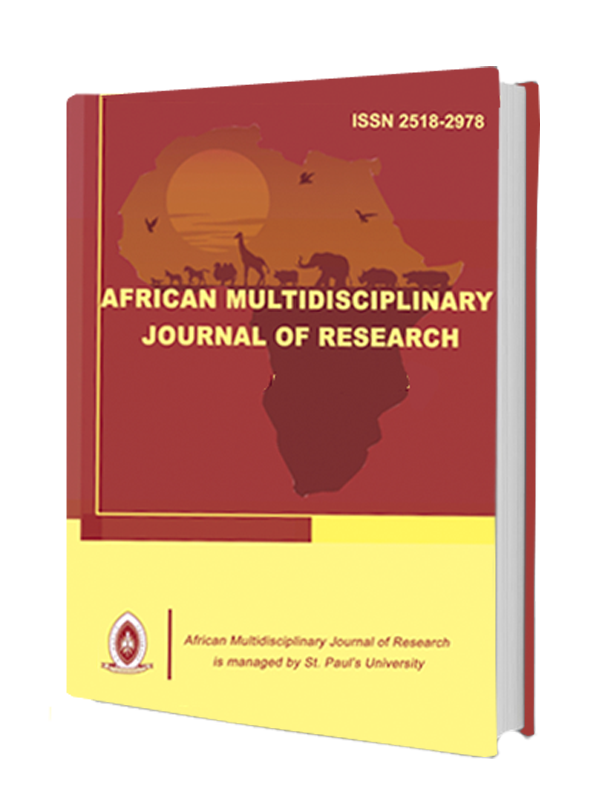Influence of Safety Rules and Procedures on Employee Performance in Nakuru Rural Water & Sanitation Company Limited, Kenya
##plugins.themes.academic_pro.article.main##
Abstract
The alarming numbers of workplace injuries and fatalities are an issue which invokes research interest to not only establish their causes, but also investigate their implications on the employee performance. The scarcity of empirical research in respect of the foregoing and particularly in the water sector, informed carrying out of this study with the objective of examining the influence of safety rules and procedures on the employee performance in Nakuru Rural Water & Sanitation Company Limited. The study was guided by the distractions theory. A descriptive research design was adopted. The 152 staff working with the aforestated water company constituted the accessible population. A sample of 74 respondents was drawn from the study population using stratified random sampling technique. Pertinent data were collected using a structured questionnaire and subsequently analyzed with the aid of the Statistical Package for Social Sciences. The results were presented in tabular format. According to the study findings, there existed a statistically significant relationship between safety rules and procedures, and employee performance (r = 0.953; p = 0.000) at p-value = 0.05. It was also revealed that influence of the said rules and procedures on employee performance was statistically significant (t = 22.341; p = 0.000). The study concluded that safety rules and procedures were of great importance to the performance of employees working with the Nakuru Rural Water and Sanitation Company. It was recommended that the safety measures put in place by the water and sanitation companies ought to be in conformity to the measures stipulated by the Occupation Safety and Health Act.
Keywords: Employee performance, Nakuru Rural Water and Sanitation Company, safety procedures, safety rules
##plugins.themes.academic_pro.article.details##
References
- Armstrong, Q. (2010). Work hours, workload, sleep and fatigue in Australian rail industry employees. Applied Ergonomics, 42, 202-209.
- Asiamah, N., Mensah, H. K., & Oteng-Abayie, E. F. (2017). General, target, and accessible population: Demystifying the concepts for effective sampling. The Qualitative Report, 22(6), 1607-1621.
- García , A. M., Merino, R. G., & Martínez , V. L. (2007). Estimate of the mortality rate attributable to occupational diseases in Spain, 2004. Rev. Esp. Salud Publica, 81(3), 261- 270.
- Hinze, J. W. (1997). Construction safety. New Jersey: Prentice Hall, Inc.
- Katsuro, P., Gadzirayi, C. T., Taruwona, M., & Mupararano, S. (2010). Impact of occupational health and safety on worker productivity: A case of Zimbabwe food industry. African Journal of Business Management, 4(13), 2644-2651.
- Kemei, R., & Nyerere, J. (2016). Occupational accident patterns and prevention measures in construction sites in Nairobi County, Kenya. American Journal of Civil Engineering, 4(5), 254-263.
- Kiliç, G., & Selvi, M. S. (2009). The effects of occupational health and safery risk factors on job satisfaction in hotel enterprises. Ege Akademik Bakış / Ege Academic Review, 9(3), 903- 921.
- Kothari, C. R., & Garg, G. (2014). Research methodology: Methods and techniques. New Delhi, India: New Age International Publishers.
- Nassiuma, D. K. (2000). Survey sampling: Theory and methods. Nairobi, Kenya: University of Nairobi Press.
- Petersen, A., & Lupton, D. (1996). The new public health: Health and self in the age of risk. One Thousand Oaks, CA: Sage Publications, Inc.
- Robson, C. (2002). Real world research (2nd ed.). Oxford: Blackwell.
- Siegrist, J. (1996). Adverse health effects of high-effort/low-reward conditions. Journal of Occupational Health Psychology, 1(1), 27-41. doi:10.1037//1076-8998.1.1.27
- Smallwood, J., Haupt, T., & Shakantu, W. (2013). Health and safety in South Africa. Pretoria, South Africa: Construction Industry Development Board of South Africa.
- Taherdoost, H. (2016). Sampling methods in research methodology: How to choose a sampling technique for research. International Journal of Academic Research in Management (IJARM), 5(2), 18-27.

